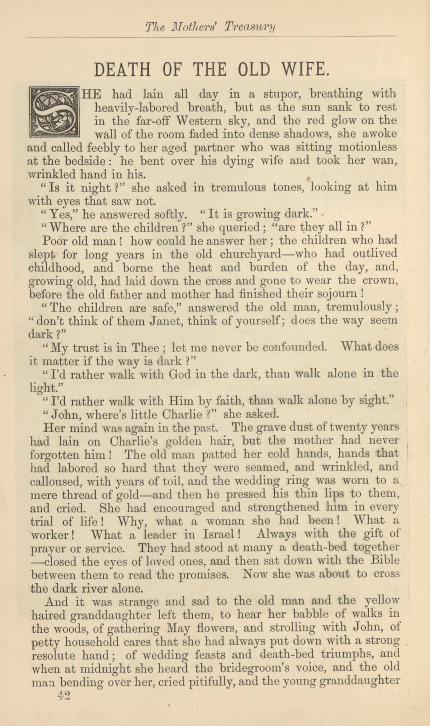Death of the Old Wife
by Anonymous
The Mothers’ Treasury, vol. 19, issue 3 (1864)
Pages 42-43

Introductory Note: This short work of fiction hails a mother’s pure love for her children, devotion to God, and loyalty to her spouse—thus fulfilling the purpose of The Mother’s Treasury. The narrative recounting a woman’s last hours on earth also outlines Victorian ideals regarding daily living and marital relationships. This gives the reader a clearer understanding of how Victorian society measured a successful marriage and individual accomplishments.
SHE had lain all day in a stupor, breathing with heavily-labored breath, but as the sun sank to rest in the far-off Western sky, and the red glow on the wall of the room faded into dense shadows, she awoke and called feebly to her aged partner who was sitting motionless at the bedside: he bent over his dying wife and took her wan, wrinkled hand in his.
“Is it night?” she asked in tremulous tones, looking at him with eyes that saw not.
“Yes,” he answered softly. “It is growing dark.”
“Where are the children?” she queried; “are they all in?”
Poor old man! how could he answer her; the children who had slept for long years in the old churchyard—who had outlived childhood, and borne the heat and burden of the day, and, growing old, had laid down the cross and gone to wear the crown, before the old father and mother had finished their sojourn!
“The children are safe,” answered the old man, tremulously; “don’t think of them Janet, think of yourself; does the way seem dark?”
“My trust is in Thee; let me never be confounded. What does it matter if the way is dark?”
“I’d rather walk with God in the dark, than walk alone in the light.”
“I’d rather walk with Him by faith, than walk alone by sight.”
“John, where’s little Charlie?” she asked.
Her mind was again in the past. The grave dust of twenty years had lain on Charlie’s golden hair, but the mother had never forgotten him! The old man patted her cold hands, hands that had labored so hard that they were seamed, and wrinkled, and calloused, with years of toil, and the wedding ring was worn to a mere thread of gold—and then he pressed his thin lips to them, and cried. She had encouraged and strengthened him in every trial of life! Why, what a woman she had been! What a worker! What a leader in Israel! Always with the gift of prayer or service. They had stood at many a death-bed together—closed the eyes of loved ones, and then sat down with the Bible between them to read the promises. Now she was about to cross the dark river alone.
And it was strange and sad to the old man and the yellow haired granddaughter left them, to hear her babble of walks in the woods, of gathering May flowers, and strolling with John, of petty household cares that she had always put down with a strong resolute hand; of wedding feasts and death-bed triumphs, and when at midnight she heard the bridegroom’s voice, and the old man bending over her, cried pitifully, and the young granddaughter kissed her pale brow, there was a solemn joy in her voice as she spoke the name of her children one by one, as if she saw them with immortal eyes, and with one glad smile put on immortality.1“Bridegroom” is a reference to the parable of the ten virgins, recounted in Matthew 25: 1-13. In the parable, the bridegroom is Christ. They led the old man sobbing away, and when he saw her again the glad morning sun was shining, the air was jubilant with the song of birds, and she lay asleep on the couch under the north window where he had seen her so often lie down to rest, while waiting for the Sabbath bell. And she wore the same best black silk, and the string of gold beads about her thin neck, and the folds of white tulle. Only now was the brooch with his miniature wanting, and in its place was a white rose and a spray of cedar—she had loved cedar—she had loved to sing over her work:
“Oh may I in His courts be seen,
Like a young cedar fresh and green.”
But what strange transformation was there? The wrinkles were gone. The traces of age, and pain, and weariness were all smoothed out; the face had grown strangely young, and a placid smile was laid on the pale lips. The old man was awed by this likeness to the bride of his youth. He kissed the unresponsive lips and said softly:
“You’ve found Heaven first, Janet, but you’ll come for me soon! It’s our first parting in over seventy years, but it won’t be for long—it won’t be for long!”
And it was not. The winter snows had not fallen, and there is another grave, and to-day would have been their diamond wedding! We had planned much for it, and I wonder—I wonder—but no! Where they are, there is neither marriage nor giving in marriage.
Word Count: 826
Original Document

Topics
How To Cite (MLA Format)
“Death of the Old Wife.” The Mothers’ Treasury, vol. 19, no. 3, 1864, pp. 42-3. Edited by Rachel Goepel. Victorian Short Fiction Project, 12 July 2025, https://vsfp.byu.edu/index.php/title/death-of-the-old-wife/.
Editors
Rachel Goepel
Lesli Mortensen
Rachel Housley
Cosenza Hendrickson
Alexandra Malouf
Posted
23 July 2020
Last modified
12 July 2025
Notes
| ↑1 | “Bridegroom” is a reference to the parable of the ten virgins, recounted in Matthew 25: 1-13. In the parable, the bridegroom is Christ. |
|---|



